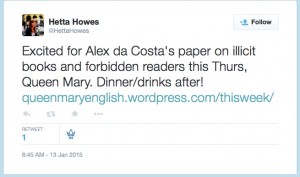Alex da Costa gave a paper at the English Graduate Research Seminar at Queen Mary University of London on 15 January examining the paratexts of early evangelical texts and how they sought to persuade readers to risk buying such forbidden material. The paper looked at censored texts from the opposite angle to her recent article ‘”Functional Ambiguity”: Negotiating Censorship in the 1530s’ in The Library, arguing that the blandness of title pages, for example, may have been less about disguising evangelical material from the censors than not scaring the wavering reader.
ABSTRACT: There has been a tendency amongst Reformation scholars to ignore the question of how the market for vernacular, evangelical writing was initially fostered and expanded. What this leaves unaddressed is the specific problem that the earliest evangelical, English writers faced if they wanted to do more than preach to the converted: how to entice resistant readers steeped in traditional religion into reading material that was both forbidden and, probably, uncomfortably challenging. Until 1534, England remained part of the Roman Church and even after the break with Rome, Henry VIII regarded himself as a Catholic, often unwilling to sanction key tenets of evangelical belief. Successive statutes, proclamations and instruments made it clear to printers and readers alike that books which strayed from accepted faith were forbidden and the possession of them was used as significant evidence of heresy. In such circumstances, obtaining texts by writers like Tyndale or Fish was not only difficult, but dangerous, so idle curiosity about newfangled heresies was unlikely to be enough to make a reader purchase such a volume. With the difficulties and risks so elevated, how did these writers and their printers make consumers of potential readers? In this paper, I want to explore the ways in which evangelical books printed in the 1520s and early 1530s deliberately sought to attract new readers and to persuade them to pay the purchase price through the manipulation of title pages, prefaces, tabula, notes, errata notices and imprints.
